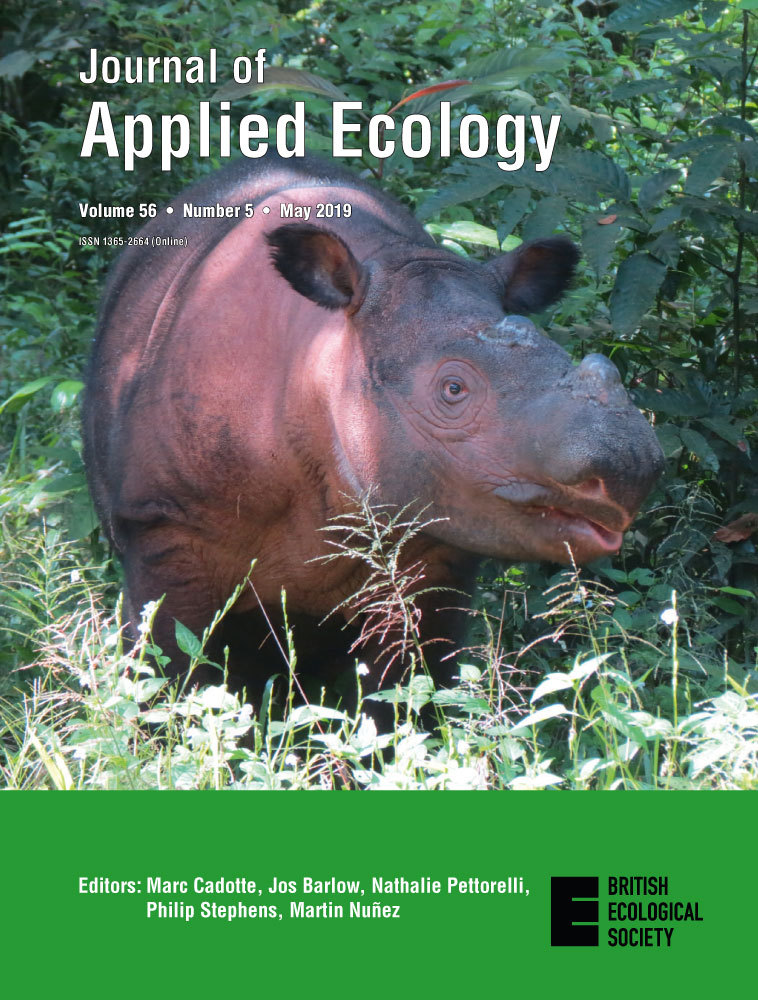Ver ítem
- xmlui.general.dspace_homeCentros Regionales y EEAsCentro Regional Patagonia SurEEA Santa CruzArtículos científicosxmlui.ArtifactBrowser.ItemViewer.trail
- Inicio
- Centros Regionales y EEAs
- Centro Regional Patagonia Sur
- EEA Santa Cruz
- Artículos científicos
- Ver ítem
Remotely‐sensed primary productivity shows that domestic and native herbivores combined are overgrazing Patagonia
Resumen
1.Carrying capacity is the maximum animal density an area can sustain without deterioration of its resources. Overgrazing has degraded Patagonia, but sheep stocks decreased and gave way to mixed systems with cattle, goats and guanacos (native wild camelids).
2.The objective of this paper was to develop a method to estimate carrying capacity based on remotely sensed data, and to assess wild and domestic herbivore numbers in order to establish if grazing
[ver mas...]
1.Carrying capacity is the maximum animal density an area can sustain without deterioration of its resources. Overgrazing has degraded Patagonia, but sheep stocks decreased and gave way to mixed systems with cattle, goats and guanacos (native wild camelids).
2.The objective of this paper was to develop a method to estimate carrying capacity based on remotely sensed data, and to assess wild and domestic herbivore numbers in order to establish if grazing stocks have evolved to balance with carrying capacity.
3.Net Primary Productivity (NPP) MOD17/A3 images and field Aerial Net Primary Productivity (ANPP) data of 66 sites were linearly regressed (R2= 0.83, P<0.01), and the slope 0.236 used to convert MOD17/A3 NPP to ANPP. Harvest index (proportion of ANPP that may be sustainably consumed) was estimated as a function of ANPP and carrying capacity as a consumable forage/ estimated annual consumption, set at 500 (sheep and goats), 3200 (cattle) and 750 kg Dry Matter.head−1.year−1 (guanacos).
4.Regional ANPP±SD (2000‐2015) was 758±52 kg Dry Matter ha−1.yr−1 and Harvest index 13.7±0.6%. Regional carrying capacity was 14.8±1.6 M sheep or goats, 2.3±0.3 M cattle or 9.9±1.2 M guanacos.
5.Domestic stock was high from 1920 to 1980, but declined thereafter and remained mostly within 1SD of mean 2000‐2015 carrying capacity. In this century annual provincial stocks and carrying capacity correlated well (R²= 0.94, p<0.01) with a slope close to 1.
6.Guanacos increased from 0.5 M to 2 M between 2000‐2015, driving linearly combined grazing pressures 36 and 62% above carrying capacity in southern Patagonia provinces in 2015.
7.Synthesis and applications. From the year 2000, after decades of sheep overstocking, domestic stock have shown a regional trend towards a grazing equilibrium, but growth of guanacos might have upset that trend. Participation of guanacos as a critical excess in total grazing pressure is debatable, but management of these populations is necessary and may be increasingly attractive if combined production systems are developed to incorporate wild meat and fibre. Our method,MOD17/A3 enables a carrying capacity evaluation and stock adjustment in these unique mixed grazing systems, preventing further rangeland degradation and loss of ecosystem services.
[Cerrar]

Autor
Oliva, Gabriel Esteban;
Paredes, Paula Natalia;
Ferrante, Daniela;
Cepeda, Carla Tamara;
Rabinovich, Jorge Eduardo;
Fuente
Journal of applied ecology (29 April 2019)
Fecha
2019-04
Editorial
Wiley; British Ecological Society
ISSN
1365-2664
Formato
pdf
Tipo de documento
artículo
Palabras Claves
Derechos de acceso
Restringido
 Excepto donde se diga explicitamente, este item se publica bajo la siguiente descripción: Creative Commons Attribution-NonCommercial-ShareAlike 2.5 Unported (CC BY-NC-SA 2.5)
Excepto donde se diga explicitamente, este item se publica bajo la siguiente descripción: Creative Commons Attribution-NonCommercial-ShareAlike 2.5 Unported (CC BY-NC-SA 2.5)

